#1930s german porcelain
Text
A Treasure Hunter's Guide to Antique Shopping
As we go through life, we often seek out hidden treasures, searching for something special that speaks to us. For some, that search takes the form of scouring antique shops and flea markets, seeking out one-of-a-kind finds that tell a story and have stood the test of time.
Antique shopping is an exciting and fulfilling experience that takes you on a journey through history, with each item telling a unique story. It's more than just a hobby; it's an opportunity to discover valuable and one-of-a-kind treasures to add to your collection. If you have a passion for porcelain figurines, plates, and other decorative items, then you may be interested in some of the most popular brands found in antique shops, such as Bing & Grondahl, Goebel, M.I. Hummel, Royal Copenhagen, and Arabia-Moomin. These brands offer a glimpse into the artistry and craftsmanship of a bygone era, making them a valuable addition to any antique collection. But where do you begin your search for these treasures? Don't worry, fellow treasure hunter, because this guide is here to help you navigate the world of antique shopping with ease. Whether you're a seasoned pro or a curious novice, these tips and tricks will help you find the hidden gems that are just waiting to be discovered. So, grab your wallet, and let's embark on a journey through time and history and discover the beauty and value of antique shopping.
Here are five well-known brands to keep an eye out for:
Arabia-MMoomin:
Since 1873, Arabia has been a leading manufacturer of fine porcelain and stoneware in Finland. The brand is renowned for both its commitment to responsible and ecological production as well as its timeless and classic designs. The Moomin collection, which includes figures from the well-liked children's book series by Tove Jansson, is among Arabia's most popular offerings. The Moomin drawings are well-liked by collectors and book lovers since they are frequently bright and amusing.
Bing & Grondahl:
Danish porcelain manufacturer Bing & Grondahl has been making hand-painted porcelain vases, plates, and figures since 1853. The business is renowned for its unique and precise designs, many of which include delicate patterns and realistic motifs. Christmas plates from Bing & Grondahl are especially well-known and have been a sought-after collector's item since 1895. These plates are both beautiful and culturally significant because they frequently depict views of Danish towns and cities during the holiday season.
GOEBEL:
German porcelain manufacturer GOEBEL has been making figurines, plates, and other adornments since 1871. The business is renowned for its commitment to quality and craftsmanship, as well as for working with eminent designers and artists. The M.I. Hummel figurines by GOEBEL, which depict adorable kids in a variety of attitudes and pursuits, are its best-known products. Since their debut in the 1930s, M.I. Hummel figurines have gained popularity among collectors and are highly prized for their attention to detail and whimsy.
M.I. Hummel:
The German business GOEBEL produces the M.I. Hummel range of porcelain figures. Sister Maria Innocentia Hummel, a Franciscan nun who illustrated children in the 1930s, served as the model for the sculptures. The miniatures are extremely detailed and frequently show kids going about their daily lives, doing things like playing or gardening. Each figurine is individually hand-made and expertly painted by artists, adding to their value and uniqueness.
Royal Copenhagen:
Since 1775, Royal Copenhagen, a Danish porcelain producer, has been creating premium porcelain. The business is well-known for its hand-painted blue and white patterns, especially its distinguishing "Blue Fluted" pattern. For their beauty and craftsmanship, Royal Copenhagen artifacts are frequently sought after by collectors. Over the years, the business has worked with renowned designers and artists, such as Grethe Meyer and Arnold Krog, to produce a wide and impressive range of porcelain items.
Finding porcelain figurines, plates, and other decorative pieces at an antique store can be a terrific way to give your home decor some personality and style. Each piece provides a window into the artistry and craftsmanship of a bygone era, whether you're looking for Bing & Grondahl elaborate patterns, GOEBEL's M.I. Hummel figures, or Royal Copenhagen's distinctive blue and white pieces. These companies and their collections are highly prized by enthusiasts and collectors, making them priceless additions to any collection of antiques.
1 note
·
View note
Text

Sisters and Brothers,
May we all have an good blessed Sunday and a new week too.
❤️🙏♾️;-)=
Sister Maria Hummel Day
is commemorated on
May 21 every year by Catholics as well as Non-Catholics.
This day honors
Sister Hummel,
A German Franciscan nun, and painter who came to prominence for her paintings, which formed the basis for the popular Hummel figurines.
However, as the Nazi party gained power in the late 1930s, her figurines were viewed as offensive, immoral, and ludicrous.
During World War II, when the convents were shut, she could make a living by selling her art. Her artwork is still sold as porcelain figurines across the world, particularly in Germany.
0 notes
Text
Dachshund Bobblehead History

The concept of the bisque porcelain Dachshund bobblehead is actually quite old. It has been around almost as long as the dog breed itself. In fact, the first known reference to a bobblehead was in Nikolai Gogol’s 1842 short story, ‘The Overcoat’, where the main character’s neck resembling plaster cats wagging their tails was described. During the nineteenth century, German companies began producing bisque porcelain bobbleheads for the American market, which were later mass-produced in large numbers. During the 1920s and 1930s, the popularity of bobbleheads skyrocketed. – Dachshund Bobblehead History
0 notes
Text
#majolica#art nouveau#vintagehome decor#antique porcelain#GS Zell Majolica plate#iris plate#1930s german porcelain
0 notes
Photo
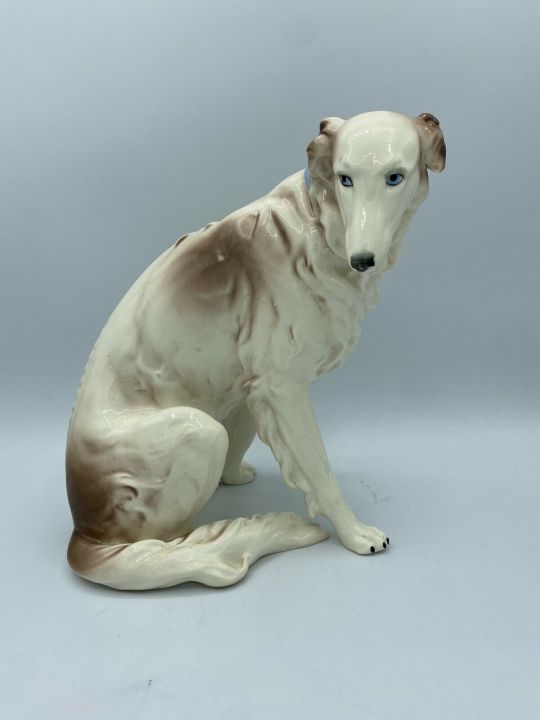
Katzhutte Borzoi (1930s) German with Blue Eyes Etched 4954 underneath
28 notes
·
View notes
Photo
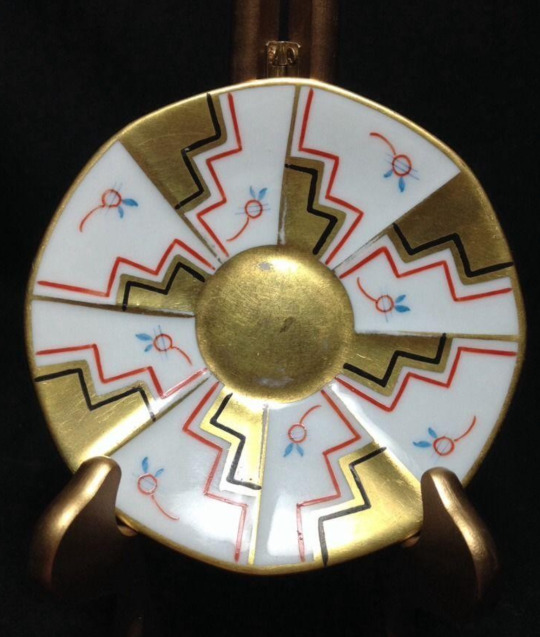

Art Deco Modernist Plate, Porzellanfabrik AL-KA Kunst Alboth & Kaiser, Germany 1926-1935.
(via worthpoint.com)
#art deco#modernism#modernist porcelain#porzellan teller#art deco style#art deco design#german porcelain#1930s#al-ka kunst#Alboth & Kaiser porcelain#porcelain plate#decorative arts
80 notes
·
View notes
Text

God
c. 1917
Morton Livingston Schamberg, American, 1881 - 1918, and Elsa von Freytag-Loringhoven, German, 1874 - 1927
In 1900 American writer Henry Adams contrasted the dynamo engine to the Virgin Mary as the icon of a new age, and in 1930 American poet Hart Crane would salute the Brooklyn Bridge as the altar of a new God. Consisting of an inverted household plumbing trap mounted on a wooden miter box, this construction offers a more tongue-in-cheek eulogy to the machine. Members of the New York Dadaists, Morton Schamberg and Elsa von Freytag-Loringhoven used irony and irreverence to topple artistic conventions. God shares a spiritual kinship with Marcel Duchamp’s notorious Fountain of 1917, a porcelain urinal turned on its side, and invokes Duchamp’s equivocal praise of plumbing and bridges as America’s greatest contributions to civilization.
Philadelphia Museum of Art
14 notes
·
View notes
Photo
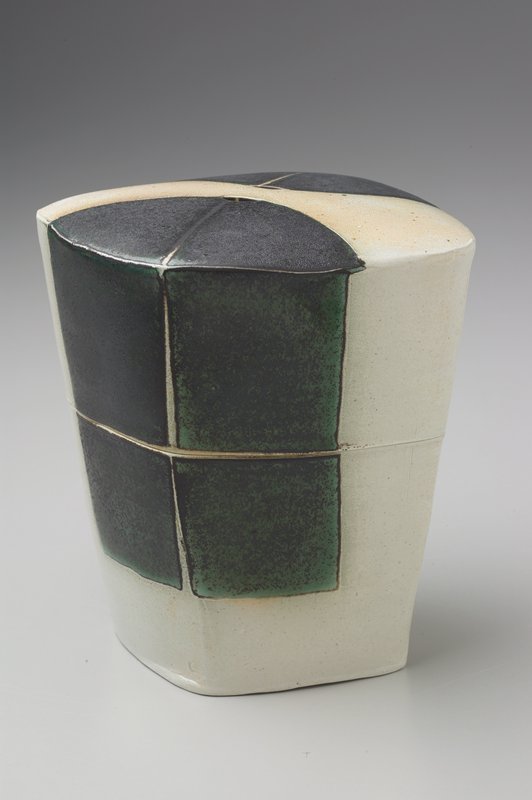
Covered box, Maren Kloppmann, 1999, Minneapolis Institute of Art: Decorative Arts, Textiles and Sculpture
diamond-shaped box, slightly flaring from base; 2 small football-shaped holes at center of lid; interior glazed green; exterior glazed white with green at 2 corners on lid and sides of box Local artists Jan McKeachie-Johnston and Maren Kloppmann's ceramics represent two dramatically different aesthetics. McKeachie-Johnston derives inspiration from an eclectic mix of historical sources - African pottery, Native American basketry, and contemporary Japanese ceramics - which are felt in the rich surface pattern, deep colors, and striking abstract form of this vessel. In contrast, the German-born Kloppmann is known for her modernist approach. Symmetrical and geometric vessels like her Covered Box convey the clean, minimalist aesthetic of Europe in the 1930s, still appreciated today.
Size: H.5-5/8 x W.5-3/4 x D.5-1/4 in. (overall)
Medium: Porcelain
https://collections.artsmia.org/art/5902/
9 notes
·
View notes
Photo

1930 c. German porcelain Josephine Baker half-doll powder dish. From The Vanity Fair-Strong Museum.
69 notes
·
View notes
Photo

Research VICTOR VASARELY
evasively was born in Pecks and grew up in Postmen (now Pisani, Slovakia) and Budapest, where, in 1925, he took up medical studies at Eotvos Loran University.
In 1927, he abandoned medicine to learn traditional academic painting at the private Pasolini-Volkmann Academy. In 1928/1929, he enrolled at Sandor Bortnick’s private art school called Muhly (lit. "Workshop", in existence until 1938), then widely recognized as Budapest's center of Bauhaus studies.
Cash-strapped, the muhly could not offer all that the Bauhaus offered. Instead, it concentrated on applied graphic art and typographical design.
In 1929, he painted his Blue Study and Green Study.
In 1930, he married his fellow student Claire Spinner (1908–1990).
Together they had two sons, Andre and Jean-Pierre.
Jean-Pierre was also an artist and used the professional name 'Viral'.
In Budapest, he worked for a ball-bearings company in accounting and designing advertising posters.
Vasa rely became a graphic designer and a poster artist during the 1930s combining patterns and organic images with each other.
Outdoor Vasarely artwork at the church of Palos in Pecks
Vasarely left Hungary and settled in Paris in 1930.
He worked as a graphic artist and as a creative consultant at the advertising agencies Havas, Draeger, and Defames (1930–1935).
His interactions with other artists during this time were limited.
He thought of opening an institution modelled after Sandor Bortnick’s muhly and developed some teaching material for it.
Having lived mostly in cheap hotels, he settled in 1942/1944 in Saint-Care in the Lot department. After the Second World War, he opened an atelier in Arcelia, a suburb about 10 kilometers from the center of Paris (in the Val-de-Marne department of the Île-de-France).
In 1961, he finally settled in Anent-sur-Marne (in the Seine-et-Marne department).
Vasarely eventually went on to produce art and sculpture using optical illusion.
Over the next three decades, Vasarely developed his style of geometric abstract art, working in various materials but using a minimal number of forms and colors:
1929–1944: Early graphics: Vasarely experimented with textural effects, perspective, shadow and light.
His early graphic period resulted in works such as Zebras (1937), Chess Board (1935), and Girl-power (1934).
1944–1947: Les Fusses Routes – On the wrong track: During this period, Vasarely experimented with cubistic, futuristic, expressionistic, symbolistic and surrealistic paintings without developing a unique style.
Afterwards, he said he was on the wrong track.
He exhibited his works in the gallery of Denise René (1946) and the gallery René Bertheau (1947).
Writing the introduction to the catalogue, Jacques Prévert placed Vasarely among the surrealists.
Prévert creates the term imaginaries (images + noir, black) to describe the paintings.
Self Portrait (1941) and The Blind Man (1946) are associated with this period.
1947–1951: Developing geometric abstract art (optical art): Finally, Vasarely found his own style.
The overlapping developments are named after their geographical heritage.
Defer refers to the works influenced by the white tiled walls of the Paris Defer – Rocher au metro station.
Ellipsoid pebbles and shells found during a vacation in 1947 at the Breton coast at Belle Île inspired him to the Belles-Isles works.
Since 1948, Vasarely usually spent his summer months in Gourdes in Provence-Alpes-Côte d'Azur.
There, the cubic houses led him to the composition of the group of works labelled Gourdes/Cristal.
He worked on the problem of empty and filled spaces on a flat surface as well as the stereoscopic view.
Tribute to Malevich (1954), Ciudad Universitario de Caracas
1951–1955: Kinetic images, black-white photography’s: From his Gourdes works he developed his kinematic images, superimposed acrylic glass panes create dynamic, moving impressions depending on the viewpoint.
In the black-white period he combined the frames into a single pane by transposing photography’s in two colors.
Tribute to Malevich, a ceramic wall picture of 100 m2 (1,100 sq ft) adorns the University of Caracas, Venezuela which he co-designed in 1954 with the architect Carlos Raúl Villanueva, is a major work of this period.
Kinetic art flourished and works by Vasarely, Calder, Duchamp, Man Ray, Soto, Tonguely were exhibited at the Denise René gallery under the title Le Movement (the motion).
Vasarely published his Yellow Manifest.
Building on the research of constructivist and Bauhaus pioneers, he postulated that visual kinetics (plastique cinétique) relied on the perception of the viewer who is considered the sole creator, playing with optical illusions.
Supernovae (1959–61) in Tate Modern
1955–1965: Folklore planetaries, permutations, and serial art: On 2 March 1959, Vasarely patented his method of unites plastique’s.
Permutations of geometric forms are cut out of a colored square and rearranged.
He worked with a strictly defined palette of colors and forms (three reds, three greens, three blues, two violets, two yellows, black, white, gray; three circles, two squares, two rhomboids, two long rectangles, one triangle, two dissected circles, six ellipses) which he later enlarged and numbered.
Out of this plastic alphabet, he started serial art, an endless permutation of forms and colors worked out by his assistants.
(The creative process is produced by standardized tools and impersonal actors which questions the uniqueness of a work of art.)
In 1963, Vasarely presented his palette to the public under the name of Folklore planetaries.
1965–: Homage à hexagon, Vega: The Tribute to the hexagon series consists of endless transformations of indentations and relief adding color variations, creating a perpetual mobile of optical illusion.
In 1965 Vasarely was included in the Museum of Modern Art exhibition The Responsive Eye, created under the direction of William C. Seitz.
His Vega series plays with spherical swelling grids creating an optical illusion of volume.
Kedzie-Ga, 1970, Screen-print in colors, Edition of 250, 50.8 cm × 50.8 cm (20.0 in × 20.0 in)
In October 1967, designer Will Burton invited Vasarely to make a presentation to Burton’s Vision '67 conference, held at New York University.
On 5 June 1970, Vasarely opened his first dedicated museum with over 500 works in a renaissance palace in Gourdes (closed in 1996).
A second major undertaking was the Foundation Vasarely in Aix-en-Provence, a museum housed in a distinct structure specially designed by Vasarely.
It was inaugurated in 1976 by French president Georges Pompidou, two years after his death.
Sadly, the museum is now in a state of disrepair, several of the pieces on display have been damaged by water leaking from the ceiling.
Also, in 1976 his large kinematic object Georges Pompidou was installed in the Centre Pompidou in Paris and the Vasarely Museum located at his birthplace in Pecks, Hungary, was established with a large donation of works by Vasarely.
In the same decade, he took a stab at industrial design with a 500-piece run of the upscale Suomi tableware by Timo Sarajevan that Vasarely decorated for the German Rosenthal porcelain maker's Studio Linnie.
In 1982, 154 specially created serigraphs were taken into space by the cosmonaut Jean-Loup Chrétien on board the French-Soviet spacecraft Salyut 7 and later sold for the benefit of UNESCO.
In 1987, the second Hungarian Vasarely museum was established in Zach Palace in Budapest with more than 400 works.
He died age 90 in Paris on 15 March 1997.
A new Vasarely exhibit was mounted in Paris at Muse end Herbed in 2012.
In 2019, a temporary exhibition of Vasarely's work entitled Le Partage des Forms was displayed in the Centre Georges Pompidou in Paris.
1970–1996: Vasarely Museum in the Saint-Firmin Palace in Gourdes, Vaucluse, France (closed in 1996)
1976: Foundation Vasarely, Aix-en-Provence, France
1976: Vasarely Museum, Pecks, Hungary
1987: Vasarely Museum, Zach Palace, Buda, Budapest, Hungary
2 notes
·
View notes
Text
Wiki Garden Gnome
Wiki Garden Gnome Article <3 Thanks Wiki
Garden gnome
Garden gnomes (German: Gartenzwerge, lit. 'garden dwarfs') are lawn ornament figurines of small humanoid creatures known as gnomes. Traditionally, the figurines depict male dwarfs wearing red pointy hats. Typically, gnomes stand between one and two feet (30 and 60 cm). A recent[when?] trend has introduced miniature gnomes of only a few inches in height. Originating as a decoration for the wealthy in Europe, garden gnomes are now prevalent in gardens and lawns throughout the western world, among all social classes, and often regarded as kitsch.
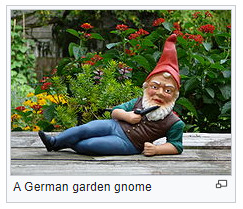
Gnomes
History
In ancient Rome, small stone statues depicting the Greco-Roman fertility god Priapus, also the protector of floors, were frequently placed in Roman gardens. Gnomes as magical creatures were first described during the Renaissance period by Swiss alchemist Paracelsus as "diminutive figures two spans in height who did not like to mix with humans". During this period, stone "grotesques", which were typically garishly painted, 1-metre-tall (3.3 ft) figurines, were commonly placed in the gardens of the wealthy. Among the figures depicted were gobbi (Italian for hunchbacks). In particular, Jacques Callot produced 21 versions of gobbi, which he engraved and printed in 1616.
Pre-twentieth century
By the late 1700s, gnome-like statues made of wood or porcelain called "gnomes" became popular household decorations. The area surrounding town of Brienz in Switzerland was known for their production of wooden house dwarfs. In Germany, these garden figurines became conflated with their traditional stories and superstitions about the "little folk" or dwarfs that they believed helped around the mines and on the farm. The Dresden company Baehr and Maresch had small ceramic statues of dwarfs or "little folk" in stock as early as 1841, and although the claim has been contested, some credit Baehr and Maresch with the first garden dwarfs (German: Gartenzwerge)

Within less than 10 years, statues of dwarfs had spread from the provinces of Saxony and Thuringia across Germany to France and, in 1847, Sir Charles Isham, brought 21 terracotta gnomes manufactured in Germany by Philip Griebel back to Britain where they were called "gnomes" in English and placed in the gardens of Isham's home, Lamport Hall in Northamptonshire. Nicknamed "Lampy", the only gnome of the original batch to survive is on display at Lamport Hall and insured for GB£1 million.
The manufacture of gnomes spread across Germany, with numerous other large and small manufacturers coming in and out of the business, each having its own particular style of design. From around 1860 onwards, many statues were made in Gräfenroda, a town in Thuringia known for its ceramics.
Garden gnomes spread to other countries in Europe in the 1840s and became particularly popular in France and Britain The term "garden gnome" may originate from the term "Gnomen-Figuren" (miniature figurines), used in the original German catalogues.
Twentieth century
Garden gnomes were further popularized when Sir Frank Crisp, the owner of the second largest collection of garden gnomes in the UK opened his Friar Park, Henley-on-Thames estate to the public at least once a week from 1910-1919. It was here where garden enthusiasts and visitors from around the world perhaps saw garden gnomes for the first time.
The reputation of German gnomes declined after World War I, but they became popular again in the 1930s following Disney's animated film Snow White and the Seven Dwarfs, when more working-class people were able to purchase them. Tom Major-Ball (father of former British prime minister John Major) was the most notable producer at that time with his company Major's Garden Ornaments.World War II and the years following were also hard on the industry, and most producers gave it up then.
Garden gnomes saw a resurgence in popularity again in the 1970s with the creation of more humorous types of gnomes. In the 1990s travelling gnome and garden gnome pranks became popular and made national news at times, where people steal a garden gnome from an unknowing person's lawn and then send the owner photos of the gnome as a practical joke before returning it.
Twenty-first century
Philip Griebel's descendants are still producing garden gnomes in Germany. As of 2008, there were an estimated 25 million garden gnomes in Germany.
Types of garden gnomes
Garden gnomes are typically male, often bearded, usually wear red phrygian caps and often have pipes. They are often shown pursuing leisurely pastimes such as fishing or napping.
Gnomes may be made from terracotta clay slip (runny clay) poured into molds. This is allowed to set up and the excess emptied from the centre, leaving a clay shell. The gnome is removed from the mold when firm, allowed to dry and then fired in a kiln until hard. Once cooled, the gnome is painted. More modern gnomes are made from resins and similar materials.
Today, many different variations of garden gnomes exist, including humorous ones ranging from the lighthearted biker or barbecuing gnome, to the more dark, such as one stabbed in the back or wearing an executioner's hood.
In popular culture and politics

Gnomes have become controversial in serious gardening circles in the UK, and were for a time banned from the prestigious Chelsea Flower Show, as the organisers claimed that they detract from the garden designs.Gnome enthusiasts accused the organisers of snobbery, as garden gnomes are popular in the gardens of working class and suburban households. The ban was lifted during 2013 to mark the show's centenary.
In the Italian movie The Monster (1994), the main character Loris, played by Roberto Benigni, is rightfully accused of stealing the garden gnome Bashful.
A subplot in the 2001 French movie Amélie revolves around a "travelling" garden gnome.
A two-foot-tall (60 cm) garden gnome with a long, white beard, red conical hat and blue coat is the central figure in Travelocity's Roaming Gnome advertising campaign which was launched in January 2004.
Gnomeo and Juliet is a 2011 British-American CGI film that is inspired by the tragedy of Romeo and Juliet featuring garden gnomes as the characters. In 2018, its sequel, Sherlock Gnomes, was released.
The Social Democratic Party of Austria (SPÖ) used garden gnomes, which they called "Coolmen", in their campaign for the 2014 regional elections in Vorarlberg. It was intended as an ironic pun since the SPÖ historically performed poorly in elections in this part of Austria and considered itself to be a political "dwarf". The campaign placed 20,000 Coolmen holding small posters with short slogans along highly frequented roads. The party made a police report after 400 of them went missing, drawing attention from the international media.
The 2010 video game Fable III includes a side mission where a collection of garden gnomes are given magical properties, which the player character must collect throughout the world.
Garden gnomes feature as the driving motivator of Old Man Henderson, whose exploits derailed a Call of Cthulhu variant tabletop roleplaying game, described on the website 1d4chan in 2010. The character Henderson's sole motivation was to "rescue" roughly $40,000 worth of garden gnomes from a local cult, not realizing that he'd given them to charity before the game's starting session.
A 2005 episode of King of the Hill titled "Yard, She Blows!" revolves around Bobby breaking Peggy's newly acquired, and very rare, garden gnome. Hank, hating the gnome, attempts to use the event to eliminate it from the front lawn.

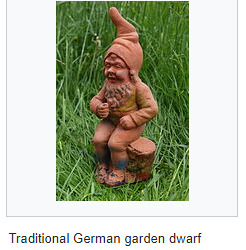
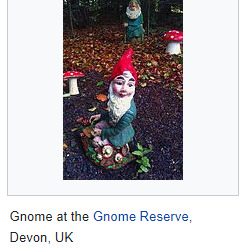
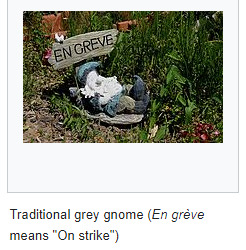
https://en.wikipedia.org/wiki/Garden_gnome
Thanks again Wiki! <3
2 notes
·
View notes
Text
Spritz-Deco
A compressor rumbling. A nozzle hissing. The colorful geometric shapes decorating this otherwise straightforward dish were not painted by hand. Rather they were applied by a device novel to the world of ceramics: the airbrush.
The important and prolific German designer, Martha Katzer (1897–1947), created this dish for the Karlsruhe Majolika Manufaktur (KMM) in Baden, Germany. Katzer arrived at the KMM in 1922, and quickly rose through the ranks. By the end of the decade, she had become a lead designer of KMM’s commercial ceramics.[1] The role came at a difficult moment in Germany. The country was still struggling economically following its disastrous defeat in World War I. Katzer’s designs for KMM, however, were able to find great commercial success because they incorporated new materials and approaches to the serial production of ceramics that made them more affordable and accessible to a broader market.
One example was the use of molded Steingut—an inexpensive porcelain substitute. Another, and more recognizable, was the introduction of Spritzdekor (airbrushing), which KMM began to implement in 1928.[2] The technique allowed for glazes to be applied quickly and evenly, leading to lower manufacturing costs. In addition, by using standardized stencils, color and decoration could be applied with greater ease and less technical training, reducing costs even further. Katzer, who had started as a ceramic painter, took to designing a number of stencils for KMM. Her designs incorporated layered geometric forms and repeating linear patterns. Influenced by the Bauhaus, this geometric aesthetic of German Art Deco had become all the rage by 1930. The combination of the simple geometry and bright, atmospheric airbrushed patterns in pastel colors led KMM to market their products as “Fröhliche Sachlichkeit” (Joyful Objectivity).
Devon Zimmerman is a Fellow in the Product Design and Decorative Arts Department at Cooper Hewitt, Smithsonian Design Museum and a PhD candidate at the University of Maryland, College Park
[1] Eva Sindler, Fröhlich, sachlich, edel: Martha Katzer, Keramik aus der Majolika-Manufaktur Karlsruhe, 1922–1942 (Karlsruhe: Badisches Landesmuseum, 2001), 10–11.
[2] Tilmann Buddensieg, Keramik in der Weimar Republik: 1919–1933 (Nurnberg: Germanisches Nationalmuseum, 1985), 11. The use of airbrushing on ceramics was studied and eventually implemented at the Staatliche keramische Fachschule zu Bunzlau (State Ceramic School in Bunzlau).
from Cooper Hewitt, Smithsonian Design Museum https://ift.tt/36SycEA
via IFTTT
3 notes
·
View notes
Photo

ART DECO MAN IN MOON CROWN TOP PERFUME BOTTLE
SCHAFER & VATER
Circa 1930
Gustav Schaefer and Guenther Vater founded the Schaefer & Vater Porcelain Factory in Volkstedt Rudolstad, Thuringa, Germany in 1890. Their aim was to make high quality porcelain.
In 1896 the business had sufficiently grown to purchase the List Porcelain Factory at Neuhaus. By 1910 the American firm of Sears Roebuck & Company had begun to import and distribute Schafer & Vater pottery into the United States.
The aim of Schafer & Vater was to produce a wide range of hard paste porcelain and was to include luxury items, figurines, and dolls' heads. They also produced soft paste porcelain in bisque items and Majolica and Jasperware were other produce lines. They produced many figural liquor bottles for distribution by pubs.
In 1913 Paul Schafer had taken over from his father and, working alongside Gunther Vater, built up a successful workforce of around 200 people, using 3 kilns. They advertised the manufacture of porcelain dolls' heads.
In 1918 the factory was destroyed by fire and they set up a new factory to resume production. The firm closed in 1962 and it is reported that in 1972 the East German government assumed full control of the vacant factory and their records and moulds were destroyed.
Schafer & Vater were better known for their comical and figural items. They manufactured these in teapots, jugs, creamers, bottles, match strikers, and planters, with a backstamp impressed with a crown above an 'R' in a star. 'Made in Germany' was sometimes stamped in black. The firm used a light blue glaze applied directly to the porcelain.
A hallmark of this pottery is the fine texture of the clay used in production. Mined locally, it was rich with kaolin and this resulted in a product with a velvety texture and very fine grain.
102 notes
·
View notes
Text
Christmases Past
by Julia Petrov, Curator of Western Canadian History
Children’s toys were often made to prepare boys and girls for their future roles. Let’s see what the ghosts of Christmas Future foretold for a few Albertan children in the 1920s and 1930s.
One lucky Alberta boy named John Scott Livingstone had a loving aunt who spoiled him and his brother and sister with presents. John’s mother was a widow, but her sister worked as a nurse, and made sure that her nephews and niece had presents every Christmas. As John lived on a farm in Olds and his aunt lived in Calgary, she purchased the presents through the Eaton’s catalogue – much like we order gifts online today!

This toy locomotive set retailed for $1.00 in the 1925-26 catalogue, about $15.00 today. It came in a large box, which was left at the foot of his bed by Santa Claus on Christmas morning. The donor and later, his children, obviously loved playing with it, because the passenger car has since been lost.
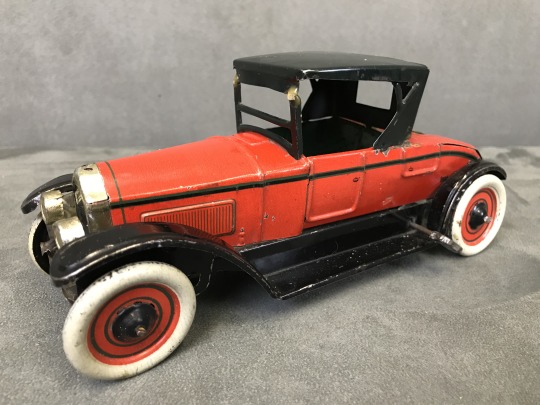

This sporty red Packard coupe car could be made to race when a key wound up the clockwork mechanism inside.
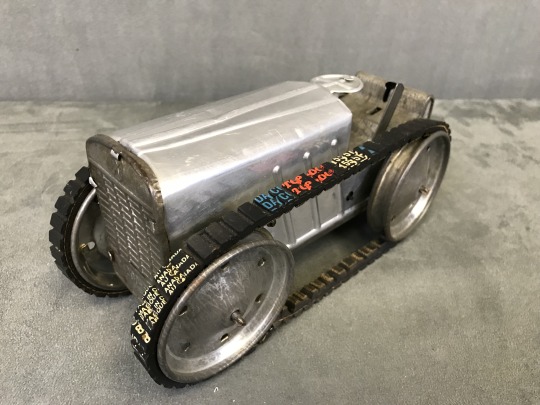

This Louis Marx & Co. wind-up tractor originally came with a figure of a farmer. Aunt Kathleen would have paid the equivalent of about $10.00 for it in around 1931. John loved to play with it on top of his mother’s ironing board. Tractors would have been a familiar sight around the area.


This German-made wind-up toy plane, which retailed for $1.00 in 1923 but only $0.50 by 1925, was so well-loved that John took it to an instructor at NAIT to make replacement parts. The propeller and wings move when the key winds the coiled spring inside.

Interactive mechanical toys were popular gifts marketed towards boys interested in engineering. Eaton’s sold several different kinds of steam engine models in the 20s and 30s. John must have learned his lesson well, because after he moved to Edmonton in the late 1940s, he worked for the natural gas provider Northwestern Utilities.
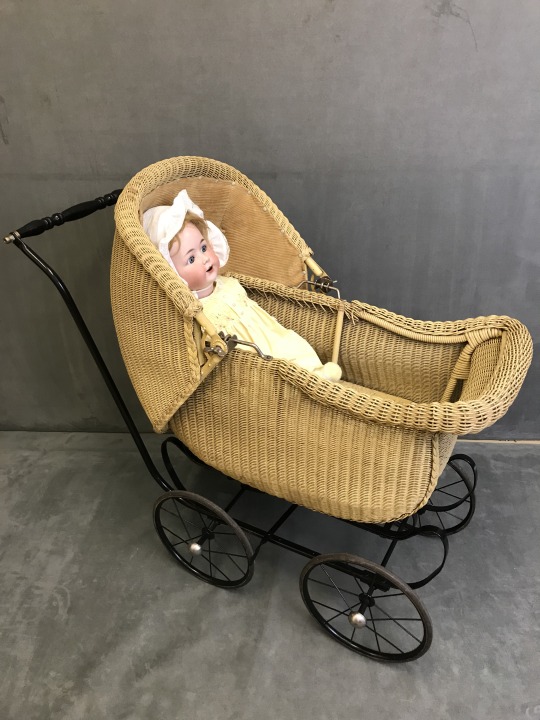
Jessica Hanna’s father managed the Edmonton Hudson’s Bay store, so he was able to purchase this expensive German porcelain doll and premium wicker doll carriage for her in 1922, when she was just 4 years old. In today’s prices, this gift would be worth around $200! The doll’s name was Marjory, and both her original hair and clothing have since been lost; the doll’s wig was replaced with Jessica’s own baby hair. Marjory’s realistic face and fully-jointed body made her a miniature baby. The carriage was also a smaller replica of popular models for real babies at the time. Jessica obviously enjoyed learning caregiving, because she served as a nurse in England and Belgium during the Second World War, and was one of the founders of the Women's Emergency Shelter and WIN House.
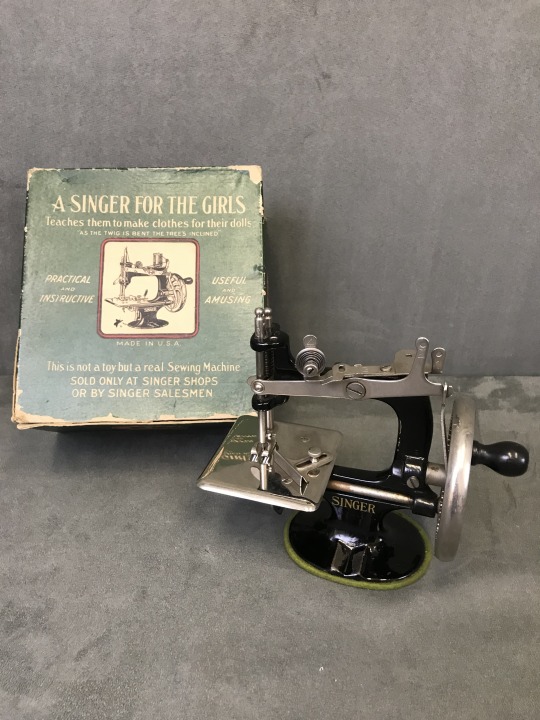
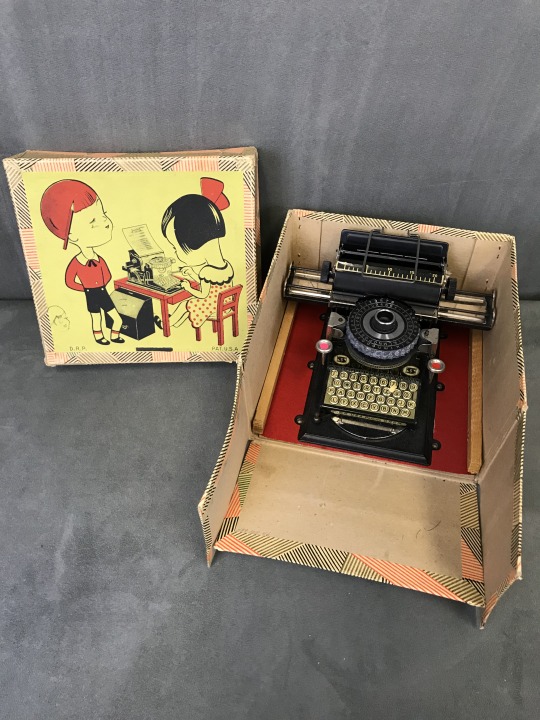

Maxine McLeod Harrison had a great Christmas in 1935, when she was given these toys. Maxine learned to sew on this miniature machine, which was bought at the Singer store on Jasper Avenue, and made clothes for her dolls, just like her mother made clothes for Maxine on her full-size Singer sewing machine. Maxine also enjoyed playing with the Gunthermann typewriter for several years until she was 11 or 12 years old. Typing was a useful skill for girls, many of whom would become administrative assistants in offices, stores, or factories, as Maxine herself did when she grew up.
11 notes
·
View notes
Link
Check out this listing I just added to my Poshmark closet: 4 Antique Crescent Bone Dishes - Kalb German Porcelain.
0 notes
Photo

German Art Deco Vases, 1930s.
(via eBay)
#decorative arts#art deco#porcelain vases#vintage#ceramics#german design#1930s#porcelain#art deco vase#european design
49 notes
·
View notes